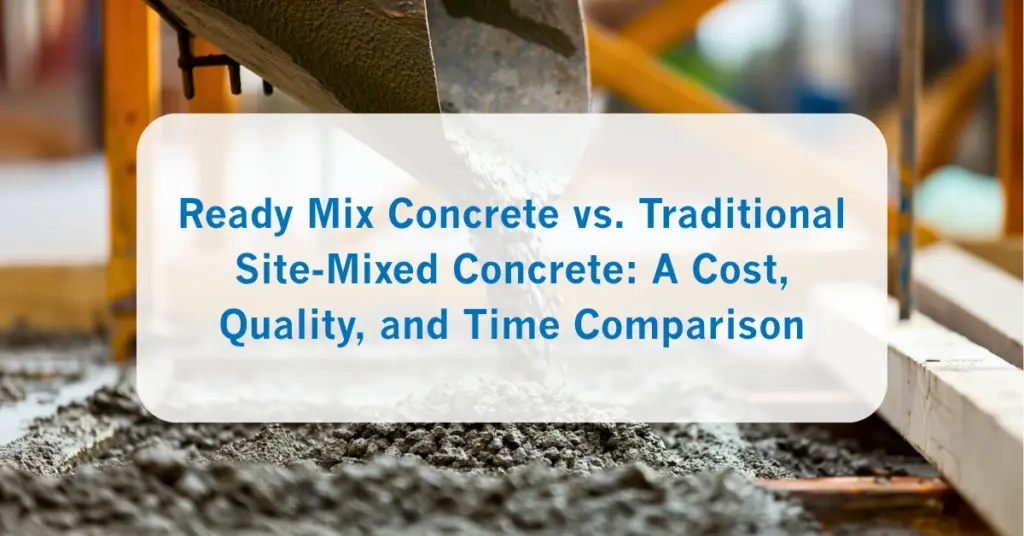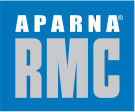Ready Mix Concrete vs. Traditional Site-Mixed Concrete: A Cost, Quality, and Time Comparison

October 13, 2025
1. Introduction
For decades, construction projects in India relied on site-mixed concrete — mixed manually on-site using cement, sand, aggregates, and water. But as projects grew in complexity and scale, the limitations of site mixing became more evident. Enter Ready Mix Concrete (RMC): a game-changing solution produced in automated plants and delivered fresh to construction sites.
This shift from traditional mixing to RMC represents not just a change in process but a transformation in quality, speed, cost-efficiency, and sustainability. Today, the debate is no longer about whether RMC is superior — it’s about how much value it brings compared to site-mixed alternatives.
2. Why the Choice Between RMC and Site-Mixed Concrete Matters
Using the wrong type of concrete impacts every aspect of construction:
- Delays: Manual mixing on-site takes hours and often slows down project timelines.
- Structural Risks: Inconsistent quality can compromise the strength and durability of the structure.
- High Long-Term Costs: While site-mixed concrete may seem cheaper upfront, maintenance and repair costs skyrocket later.
- Regulatory Compliance: Large-scale projects increasingly mandate RMC for safety and quality assurance.
3. Key Factors in the RMC vs Site-Mixed Concrete Comparison
a. Quality & Consistency
- Site-Mixed: Highly dependent on labor skill and local materials. Variations in water-cement ratio and improper mixing often weaken the final product.
- RMC: Produced in SCADA-controlled batching plants with precision and strict quality checks. Each batch is consistent, reliable, and tested for strength.
b. Time Efficiency
- Site-Mixed: Mixing, measuring, and curing on-site is time-consuming, delaying construction stages.
- RMC: Delivered directly in transit mixers — ready for use, speeding up concreting activities and enabling faster project completion.
c. Cost Implications
- Site-Mixed: Appears cheaper initially but leads to hidden costs such as excess labor, wastage, rework, and higher maintenance in the long run.
- RMC: Slightly higher upfront cost but saves significantly through reduced wastage, faster timelines, and lower lifetime maintenance.
d. Environmental Impact
- Site-Mixed: Generates high dust, noise, and material wastage, contributing to pollution on-site.
- RMC: Uses eco-friendly alternatives like fly ash and GGBS, while centralized batching reduces dust and noise at construction sites.
e. Space & Logistics
- Site-Mixed: Requires large storage areas for sand, aggregates, and cement, often cluttering sites.
- RMC: Delivered in mixers, reducing the need for material storage and keeping sites cleaner and safer.
4. Checklist Questions for Contractors and Developers
- How important is consistency and durability for your project (residential, commercial, or infrastructure)?
- Do you have the space and manpower to handle on-site storage and manual mixing?
- Would faster completion timelines help you save on overheads and financing costs?
- Are you aiming for eco-friendly or LEED-certified construction standards?
- What are the hidden costs of repairs and rework if you opt for site-mixed concrete?
5. How Aparna RMC Provides the Advantage Over Site-Mixed Concrete
Aparna RMC is at the forefront of India’s concrete revolution, offering:
- SCADA-Controlled Precision: Every mix is scientifically designed and digitally monitored to ensure flawless quality.
- Diverse Portfolio of Mixes: From M20–M80 standard grades to self-compacting, fiber-reinforced, lightweight, and green concrete, Aparna provides solutions for all project types.
- 36+ Batching Plants & 350+ Transit Mixers: Wide coverage ensures on-time delivery across metro cities and tier-II towns.
- Eco-Friendly Practices: Incorporation of M-sand, GGBS, and water recycling aligns projects with sustainability goals.
- Trusted Track Record: Aparna has supplied concrete for metros, airports, high-rises, IT parks, and industrial facilities, ensuring world-class quality for India’s biggest projects.
By replacing site-mixed methods with Aparna RMC, contractors gain not only superior quality but also peace of mind that their projects will stand strong for generations.
6. Conclusion
The comparison between site-mixed concrete and Ready Mix Concrete highlights a clear winner. While site mixing might appear economical, it falls short on consistency, durability, safety, and long-term value. RMC, on the other hand, offers a scientific, reliable, and future-ready solution for construction that demands both speed and strength.
👉 With Aparna RMC, builders and developers don’t just save time and money — they invest in quality, sustainability, and the assurance of lasting strength.
7. FAQs
Q1: Is Ready Mix Concrete always more expensive than site-mixed concrete?
Not necessarily. While initial costs may be slightly higher, RMC reduces wastage, speeds up work, and lowers long-term repair and maintenance costs, making it more economical overall.
Q2: Can RMC be customized for specific project needs?
Yes. Aparna RMC offers specialized mixes like fiber-reinforced, lightweight, and self-compacting concrete tailored to unique project requirements.
Q3: Why is RMC considered safer for construction sites?
Because it reduces on-site dust, noise, and clutter from raw material storage, making construction environments cleaner and safer
